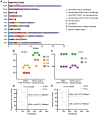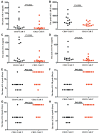Anti-CD22 CAR-T Cell Therapy as a Salvage Treatment in B Cell Malignancies Refractory or Relapsed After Anti-CD19 CAR-T therapy
- PMID: 34239307
- PMCID: PMC8259947
- DOI: 10.2147/OTT.S312904
Anti-CD22 CAR-T Cell Therapy as a Salvage Treatment in B Cell Malignancies Refractory or Relapsed After Anti-CD19 CAR-T therapy
Abstract
Background: To observe efficacy of the anti-CD22 chimeric antigen receptor modified (anti-CD22-CAR) T cell salvage therapy in relapsed/refractory (R/R) diffuse large B-cell lymphoma (DLBCL) and B cell acute lymphoid leukemia (B-ALL) patients whose disease did not reach CR or progressed again after anti-CD19-CAR T cell therapy.
Methods: In our study, seven R/R DLBCL patients reached stable disease (SD) or progression of disease (PD) after their anti-CD19-CAR T cell therapy. Only three in all the six R/R B-ALL patients obtained complete response (CR)/CR with incomplete count recovery (Cri) in their anti-CD19-CAR T cell therapy, but they relapsed again in the following three, six and one months. Then, all these thirteen R/R DLBCL and B-ALL patients received anti-CD22 CAR-T cell salvage therapy because their disease did not reach CR or progressed again.
Results: Four R/R DLBCL patients obtained CR, while two R/R DLBCL patients achieved PR and one patient achieved SD. But only two R/R B-ALL patients obtained Cri in their anti-CD22 CAR-T cell salvage therapy. The overall survival (OS) of R/R DLBCL patients after the anti-CD22 CAR-T cell therapy was 6.142±3.395 months until August 31, 2020. There was no different of the median expansion peaks of the two kinds of CAR T cells (P=0.920). The time of anti-CD22-CAR T cell proportion peak days was later than that of the time of anti-CD19-CAR T cell peak days post infusion (P=0.022). Their cytokine release syndrome (CRS) was graded 2-4 in their anti-CD19-CAR T cell therapy, while the notable CRS was graded 1-2 in their anti-CD22-CAR T cell therapy. But there was no difference in the CRS and the immune effect or cell associated neurotoxic syndrome (ICANS) grades in the two kinds of therapies. And there was no difference in the hematological toxicity grades in the two kinds of therapies.
Conclusion: The anti-CD22-CAR T cell salvage therapy is highly effective in R/R DLBCL patients than in R/R B-ALL patients who failed in anti-CD19-CAR T cell therapy before. We need to expand the number of R/R DLBCL or B-ALL patients and continue to observe.
Trial registration: ChiCTR-ONN-16009862 and ChiCTR1800019298.
Keywords: CAR; acute lymphoblastic leukemia; anti-CD19; anti-CD22; chimeric antigen receptor; diffuse large B-cell lymphoma.
© 2021 Zhu et al.
Conflict of interest statement
The authors declare that they have no conflict of interests.
Figures







Similar articles
-
Blinatumomab as salvage therapy in patients with relapsed/refractory B-ALL who have failed/progressed after anti-CD19-CAR T therapy.Ann Med. 2023 Dec;55(1):2230888. doi: 10.1080/07853890.2023.2230888. Ann Med. 2023. PMID: 37417690 Free PMC article.
-
An exploration of the initiation time and patient selection of PD-1 inhibitors/PD-1 inhibitors combined with chemotherapy as salvage therapy in R/R DLBCL patients after anti-CD19-CAR T-cell therapy.Cell Transplant. 2025 Jan-Dec;34:9636897251338713. doi: 10.1177/09636897251338713. Epub 2025 Jun 5. Cell Transplant. 2025. PMID: 40474425 Free PMC article.
-
A novel and efficient CD22 CAR-T therapy induced a robust antitumor effect in relapsed/refractory leukemia patients when combined with CD19 CAR-T treatment as a sequential therapy.Exp Hematol Oncol. 2022 Mar 22;11(1):15. doi: 10.1186/s40164-022-00270-5. Exp Hematol Oncol. 2022. PMID: 35317863 Free PMC article.
-
Efficacy and safety of CD19 combined with CD22 or CD20 chimeric antigen receptor T-cell therapy for hematological malignancies.Front Immunol. 2025 May 13;16:1577360. doi: 10.3389/fimmu.2025.1577360. eCollection 2025. Front Immunol. 2025. PMID: 40433368 Free PMC article.
-
Differences in efficacy and safety among CAR-Ts anti-CD19/CD22, anti-CD19, and anti-CD22, in adult patients with relapse/refractory B-cell acute lymphoblastic leukemia: a meta-analysis and systematic review.Leuk Lymphoma. 2023 Nov-Dec;64(11):1822-1831. doi: 10.1080/10428194.2023.2243357. Epub 2023 Aug 7. Leuk Lymphoma. 2023. PMID: 37548560
Cited by
-
The Landscape of Nucleic-Acid-Based Aptamers for Treatment of Hematologic Malignancies: Challenges and Future Directions.Bioengineering (Basel). 2022 Nov 2;9(11):635. doi: 10.3390/bioengineering9110635. Bioengineering (Basel). 2022. PMID: 36354547 Free PMC article. Review.
-
CAR-T Cell Therapy in Hematological Malignancies: Current Opportunities and Challenges.Front Immunol. 2022 Jun 10;13:927153. doi: 10.3389/fimmu.2022.927153. eCollection 2022. Front Immunol. 2022. PMID: 35757715 Free PMC article. Review.
-
Decitabine-primed tandem CD19/CD22 CAR-T therapy in relapsed/refractory diffuse large B-cell lymphoma patients.Front Immunol. 2022 Aug 17;13:969660. doi: 10.3389/fimmu.2022.969660. eCollection 2022. Front Immunol. 2022. PMID: 36059523 Free PMC article. Clinical Trial.
-
Relapse Mechanism and Treatment Strategy After Chimeric Antigen Receptor T-Cell Therapy in Treating B-Cell Hematological Malignancies.Technol Cancer Res Treat. 2022 Jan-Dec;21:15330338221118413. doi: 10.1177/15330338221118413. Technol Cancer Res Treat. 2022. PMID: 35989682 Free PMC article.
-
Prognostic factors of second hematopoietic allogeneic stem cell transplantation among hematological malignancy patients relapsed after first hematopoietic stem cell transplantation: A single center study.Front Immunol. 2023 Jan 4;13:1066748. doi: 10.3389/fimmu.2022.1066748. eCollection 2022. Front Immunol. 2023. PMID: 36685540 Free PMC article.
References
LinkOut - more resources
Full Text Sources
Research Materials

